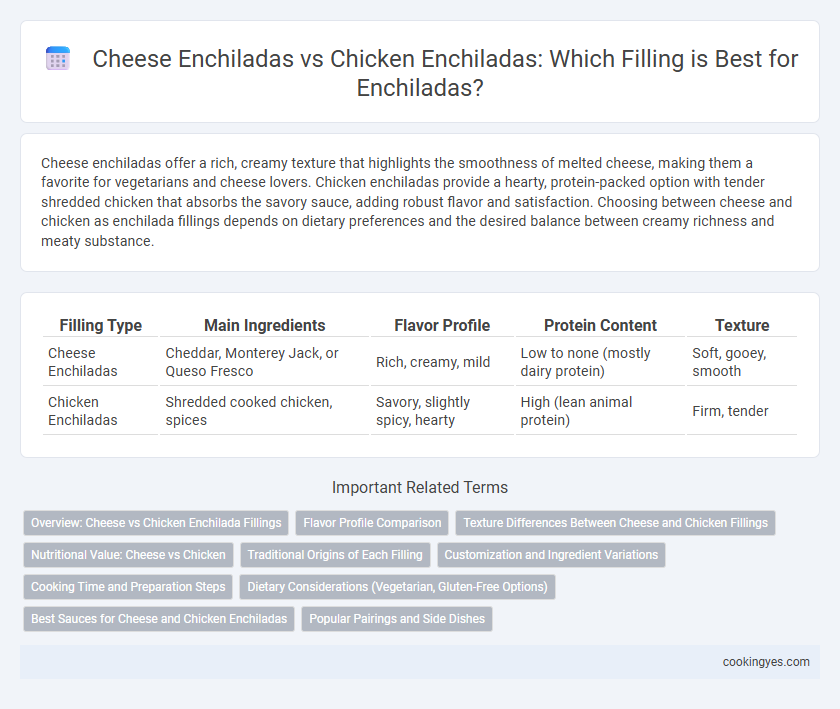Cheese enchiladas offer a rich, creamy texture that highlights the smoothness of melted cheese, making them a favorite for vegetarians and cheese lovers. Chicken enchiladas provide a hearty, protein-packed option with tender shredded chicken that absorbs the savory sauce, adding robust flavor and satisfaction. Choosing between cheese and chicken as enchilada fillings depends on dietary preferences and the desired balance between creamy richness and meaty substance.
Table of Comparison
| Filling Type | Main Ingredients | Flavor Profile | Protein Content | Texture |
|---|---|---|---|---|
| Cheese Enchiladas | Cheddar, Monterey Jack, or Queso Fresco | Rich, creamy, mild | Low to none (mostly dairy protein) | Soft, gooey, smooth |
| Chicken Enchiladas | Shredded cooked chicken, spices | Savory, slightly spicy, hearty | High (lean animal protein) | Firm, tender |
Overview: Cheese vs Chicken Enchilada Fillings
Cheese enchiladas feature a rich, creamy filling made primarily from melted cheeses like cheddar, Monterey Jack, or queso fresco, offering a smooth and indulgent flavor profile. Chicken enchiladas include shredded or diced chicken, often cooked with spices, providing a protein-packed and savory option that complements the enchilada sauce. Both variations are typically rolled in corn tortillas and baked, with cheese enchiladas highlighting a gooey texture while chicken enchiladas emphasize a hearty, meaty bite.
Flavor Profile Comparison
Cheese enchiladas offer a rich and creamy flavor profile highlighted by melted cheese varieties like cheddar or Monterey Jack, creating a smooth and indulgent taste experience. Chicken enchiladas provide a savory, hearty flavor with tender shredded chicken infused with spices such as cumin, chili powder, and garlic, delivering a robust and satisfying bite. The contrast lies in cheese enchiladas' mild and creamy essence versus chicken enchiladas' spiced, protein-packed intensity.
Texture Differences Between Cheese and Chicken Fillings
Cheese enchiladas feature a creamy, smooth texture that melts in the mouth, providing a rich and indulgent experience. Chicken enchiladas offer a firmer, more fibrous texture with a savory bite that adds substantial heartiness to each serving. The contrast between the velvety cheese filling and the tender, shredded chicken creates distinct sensory experiences tailored to different preferences.
Nutritional Value: Cheese vs Chicken
Cheese enchiladas provide a rich source of calcium and protein, primarily from cheese, but often contain higher saturated fat and calorie levels compared to chicken enchiladas. Chicken enchiladas offer lean protein with lower fat content and essential nutrients like vitamin B6 and niacin, supporting muscle maintenance and metabolism. Choosing between cheese and chicken fillings depends on dietary goals, balancing protein intake with fat and calorie considerations.
Traditional Origins of Each Filling
Cheese enchiladas trace their origins to traditional Mexican cuisine, where corn tortillas are filled with queso fresco or other regional cheeses, often accompanied by a rich chili sauce that enhances the dish's authentic flavors. Chicken enchiladas evolved as a hearty variation featuring shredded or diced chicken, typically marinated with traditional spices and combined with mole or salsa roja, reflecting indigenous and Spanish culinary influences. Both fillings highlight distinct regional practices: cheese enchiladas emphasize dairy-based simplicity, while chicken enchiladas showcase the integration of protein and complex sauces in Mexican gastronomy.
Customization and Ingredient Variations
Cheese enchiladas offer a creamy, rich base that pairs well with various chili sauces and toppings, making them highly customizable for different palates, including options like jalapenos, onions, or fresh cilantro. Chicken enchiladas provide a protein-packed filling that can be seasoned with spices such as cumin, garlic, and chili powder, allowing for diverse flavor profiles from smoky to spicy depending on the sauce and additional ingredients added. Both types support ingredient variations like black beans, corn, or avocado slices, enabling tailored nutrition and taste preferences for a personalized enchilada experience.
Cooking Time and Preparation Steps
Cheese enchiladas typically have a shorter cooking time and simpler preparation steps, as they mainly require melting cheese and warming tortillas before baking. Chicken enchiladas involve longer preparation due to cooking and shredding the chicken, often combined with sauteing onions or spices, which extends overall cooking time. Both variations bake for about 20-25 minutes, but chicken enchiladas require additional steps that make the preparation more time-consuming.
Dietary Considerations (Vegetarian, Gluten-Free Options)
Cheese enchiladas offer a vegetarian-friendly option rich in protein and calcium, making them suitable for those avoiding meat. Both cheese and chicken enchiladas can be made gluten-free by using corn tortillas instead of flour tortillas, catering to gluten-sensitive individuals. For a balanced diet, cheese enchiladas provide higher dairy content, while chicken enchiladas deliver lean protein, allowing for dietary customization based on nutritional needs.
Best Sauces for Cheese and Chicken Enchiladas
Cheese enchiladas pair exceptionally well with rich, creamy sauces like white queso or tangy green chile sauce, enhancing the mild, melty cheese filling. Chicken enchiladas benefit from bold, flavorful sauces such as robust red chili sauce or smoky chipotle sauce, which complement the savory, tender chicken. Selecting the right sauce intensifies the overall taste experience and highlights each filling's unique textures and flavors.
Popular Pairings and Side Dishes
Cheese enchiladas are popularly paired with mild red or green sauces that complement their creamy texture, often served alongside refried beans and Mexican rice to balance richness. Chicken enchiladas typically feature spiced red or verde sauces, with side dishes like grilled corn, pico de gallo, and guacamole enhancing their savory, protein-rich filling. Both varieties benefit from toppings like sour cream and fresh cilantro, which add freshness and depth to the overall flavor profile.
Cheese enchiladas vs chicken enchiladas for filling Infographic

 cookingyes.com
cookingyes.com